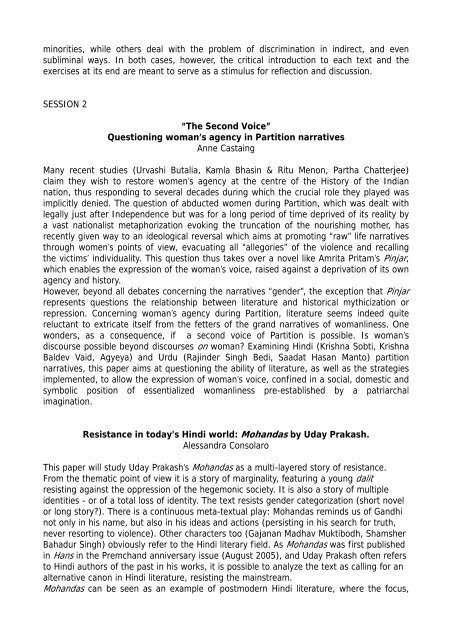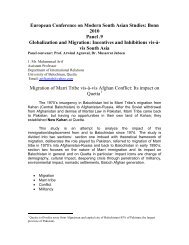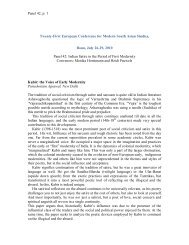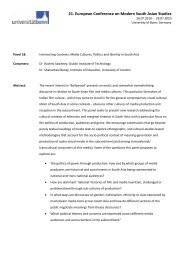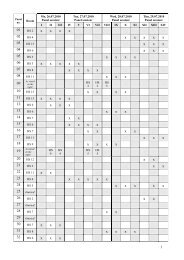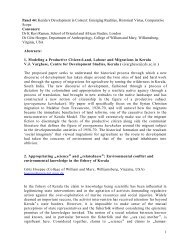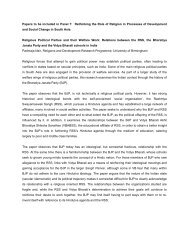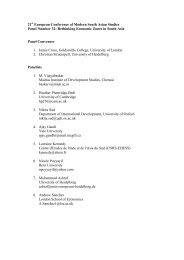European Conference on Modern South Asian Studies 2010
European Conference on Modern South Asian Studies 2010
European Conference on Modern South Asian Studies 2010
Create successful ePaper yourself
Turn your PDF publications into a flip-book with our unique Google optimized e-Paper software.
minorities, while others deal with the problem of discriminati<strong>on</strong> in indirect, and even<br />
subliminal ways. In both cases, however, the critical introducti<strong>on</strong> to each text and the<br />
exercises at its end are meant to serve as a stimulus for reflecti<strong>on</strong> and discussi<strong>on</strong>.<br />
SESSION 2<br />
“The Sec<strong>on</strong>d Voice”<br />
Questi<strong>on</strong>ing woman’s agency in Partiti<strong>on</strong> narratives<br />
Anne Castaing<br />
Many recent studies (Urvashi Butalia, Kamla Bhasin & Ritu Men<strong>on</strong>, Partha Chatterjee)<br />
claim they wish to restore women’s agency at the centre of the History of the Indian<br />
nati<strong>on</strong>, thus resp<strong>on</strong>ding to several decades during which the crucial role they played was<br />
implicitly denied. The questi<strong>on</strong> of abducted women during Partiti<strong>on</strong>, which was dealt with<br />
legally just after Independence but was for a l<strong>on</strong>g period of time deprived of its reality by<br />
a vast nati<strong>on</strong>alist metaphorizati<strong>on</strong> evoking the truncati<strong>on</strong> of the nourishing mother, has<br />
recently given way to an ideological reversal which aims at promoting “raw” life narratives<br />
through women’s points of view, evacuating all “allegories” of the violence and recalling<br />
the victims’ individuality. This questi<strong>on</strong> thus takes over a novel like Amrita Pritam’s Pinjar,<br />
which enables the expressi<strong>on</strong> of the woman’s voice, raised against a deprivati<strong>on</strong> of its own<br />
agency and history.<br />
However, bey<strong>on</strong>d all debates c<strong>on</strong>cerning the narratives “gender”, the excepti<strong>on</strong> that Pinjar<br />
represents questi<strong>on</strong>s the relati<strong>on</strong>ship between literature and historical mythicizati<strong>on</strong> or<br />
repressi<strong>on</strong>. C<strong>on</strong>cerning woman’s agency during Partiti<strong>on</strong>, literature seems indeed quite<br />
reluctant to extricate itself from the fetters of the grand narratives of womanliness. One<br />
w<strong>on</strong>ders, as a c<strong>on</strong>sequence, if a sec<strong>on</strong>d voice of Partiti<strong>on</strong> is possible. Is woman’s<br />
discourse possible bey<strong>on</strong>d discourses <strong>on</strong> woman? Examining Hindi (Krishna Sobti, Krishna<br />
Baldev Vaid, Agyeya) and Urdu (Rajinder Singh Bedi, Saadat Hasan Manto) partiti<strong>on</strong><br />
narratives, this paper aims at questi<strong>on</strong>ing the ability of literature, as well as the strategies<br />
implemented, to allow the expressi<strong>on</strong> of woman’s voice, c<strong>on</strong>fined in a social, domestic and<br />
symbolic positi<strong>on</strong> of essentialized womanliness pre-established by a patriarchal<br />
imaginati<strong>on</strong>.<br />
Resistance in today’s Hindi world: Mohandas by Uday Prakash.<br />
Alessandra C<strong>on</strong>solaro<br />
This paper will study Uday Prakash’s Mohandas as a multi-layered story of resistance.<br />
From the thematic point of view it is a story of marginality, featuring a young dalit<br />
resisting against the oppressi<strong>on</strong> of the hegem<strong>on</strong>ic society. It is also a story of multiple<br />
identities - or of a total loss of identity. The text resists gender categorizati<strong>on</strong> (short novel<br />
or l<strong>on</strong>g story?). There is a c<strong>on</strong>tinuous meta-textual play: Mohandas reminds us of Gandhi<br />
not <strong>on</strong>ly in his name, but also in his ideas and acti<strong>on</strong>s (persisting in his search for truth,<br />
never resorting to violence). Other characters too (Gajanan Madhav Muktibodh, Shamsher<br />
Bahadur Singh) obviously refer to the Hindi literary field. As Mohandas was first published<br />
in Hans in the Premchand anniversary issue (August 2005), and Uday Prakash often refers<br />
to Hindi authors of the past in his works, it is possible to analyze the text as calling for an<br />
alternative can<strong>on</strong> in Hindi literature, resisting the mainstream.<br />
Mohandas can be seen as an example of postmodern Hindi literature, where the focus,


